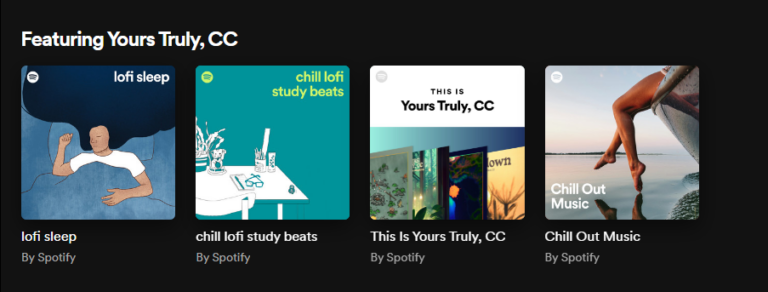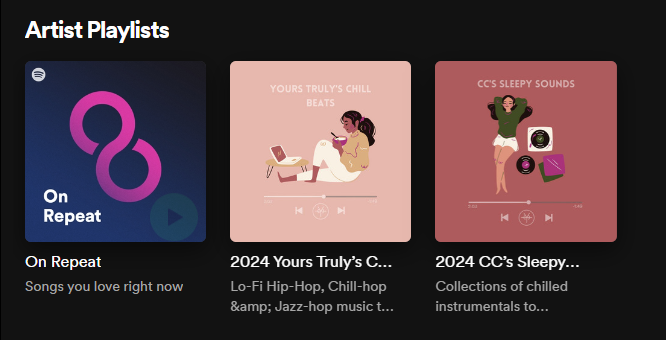Getting your first 1,000 streams on Spotify
Published: April 13, 2024
Written by Yours Truly, CC
10 min. read
1,000 streams on Spotify. It’s one of the first milestones for any independent artist to hit and yet many never reach it! This article explores the different strategies that artists can use to help them get their first thousand streams (and beyond) on the most popular digital streaming platform in the music industry.
Make the most of Spotify Playlisting
There are three types of playlists on Spotify: Editorial playlists, algorithmic playlists and user-generated playlists. All three are effective in their own ways of helping an artist gain exposure to new listeners and build a new audience.
Firstly, we have Editorial playlists. These are curated by Spotify’s in-house editorial team and can provide exposure to a really large audience. They can be generic playlists such as New Music Friday or Today’s Top Hits or they could be genre specific labels such as Lofi Beats or Chill Lofi Study Beats. As you can see, the number of followers on these playlists are very high and landing on one would all but guarantee that you would reach 1,000 plays. They are, however, extremely difficult to get into – especially in the last couple of years. And the problem is that when releasing your music independently, outside of pitching our songs to these playlists via Spotify For Artists, there’s there is very little we can do ourselves to control whether our songs will end up in these playlists. So whilst it’s useful to be aware of them I wouldn’t plan too much of your strategy around these playlists. That being said, we should still pitch our upcoming music to these Spotify playlists, and Spotify suggest that you pitch your music at least 7 days before its release date so their editors have time to listen to the song to decide if it goes on an Editorial playlist. Additionally, pitching your music a week in advance of your song’s release will also guarantee that the song lands on the release radar of all of you followers (more on that later!). Some industry experts suggest that you may want to submit your music up to 4 weeks ahead of its release date to Spotify but this would prevent you from releasing more than one song every 4 weeks if that’s what you want to. Ultimately, you should always aim to pitch your next upcoming release as soon as possible and leave at least one week between each of your releases.

So algorithmic playlists, are playlists such as “Discover Weekly” “Release Radar” and “Radio”. As the name suggests, these playlists are auto-generated through the use of complex algorithms based on user listening habits, and these playlists aim to introduce the listener to similar music to what they usually listen to or what they had just been listening to. No one can directly control any of these playlist, but there are things you can do that will influence the algorithm that creates the. This is covered in great detail throughout the rest of the article. But in summary, if you follow best practices and correctly influence the algorithm, Spotify will suggest your music to people they think will like it.
Finally, there are user-generated playlists are created by any Spotify user and can be customised however the user likes. There are millions of user generated playlists on the app and The Lofi girl – beats to relax/study to playlist is one of the best examples of how popular and they can become. And just like editorial playlists, the higher the number of followers a playlist has, the more users the music on the playlist will be exposed to. However, just because a playlist is public it doesn’t mean that you can submit to it, so you do need to know what playlists you can submit to and how. Platforms such as dailyplaylists, soundplate, can help you find and submit thousands of playlists so that you can really get those first few listeners in.
A very important thing to be aware of when it comes to submitting music to user-generated playlists is issue of “fake streams” and “botting”. Fake streams are essentially means streams are being generated by non-humans activity i.e. someone has set up dozens of multiple devices (bots) to stream a selection of songs on loop. Getting fake streams can not only damage the data in your account that’s used to get you onto algorithmic playlists but is actually against Spotify’s rules and can lead to having the targeted song(s) removed or even a worst case scenario, have your whole catalogue removed. There are, however, plenty of ways to spot botted playlists, and one of the best ways is to use sites such as https://www.artist.tools/bot-checker or https://www.isitagoodplaylist.com/ to get an idea on the quality of the playlist. Another good tip to note is that these playlists often charge a fee – so if you have to pay to be on the playlist it’s better to avoid it. So when it comes to user-generated playlists – approach this strategy with caution!
Create your own playlist… and listen to it regularly
Continuing with the playlist theme, the second strategy is to make your own playlist with your music and similar artists in it and listen to it regularly. It would be even better if you include artists who also have a similar level of listenership to yourself. Here’s why, before Spotify can suggest your music to other people using the algorithms, it needs some data about your music to begin with.

So if you put your music in a playlist with other similar artists and listen to it, you’re telling Spotify that the people who listen to your music want to listen to the other artists on our playlist. But you’re also telling Spotify that the listeners of the other artist want to listen to your music and in turn this can trigger Spotify to suggest your music to listeners who listen to those similar artists you have put in your own playlist. Furthermore, if you make your playlist public and are able to grow it, you could potentially benefit from multiple people listening to it as well as yourself which will further increase your listenership.
Release music consistently
This is something you’ll hear from almost any industry expert, and the reason why is because it’s true. As you release music consistently, you’ll not only get better at making music but you’ll also develop a refined process to for the marketing and promotion of your music and help you determine which playlists best fit your music style and generate organic streams – organic streams are streams that are generated from human activity i.e. the opposite of fake streams. Secondly, and almost more importantly, releasing consistently will help improve your algorithmic reach on as by having new music out regularly you have more chance of being shown on the algorithmic playlists.
Get followers on Spotify
Reiterating an earlier point, as long as you pitch your upcoming release to Spotify at least 7 days before it’s released, the song is guaranteed to land on the Release Radar of your followers. However, you will need to have followers so that you can benefit from this. Getting followers on Spotify is not straightforward and may require some creativity and/or trial and error to find something that works for you. A method that has seen success in the past is artists who have made remixes of other songs that are available as free downloads in exchange for a follow on Spotify. But whatever method you try, think of the value you could offer someone in exchange for a follow rather than just asking someone to follow you.
Collaborate with other artists
This is an often overlooked strategy, but it can be an incredible way to get your music in front of the listeners of other artists by sharing audiences and can lead to a snowball effect of new listeners. For example, if a user who normally listens to the artist you have collaborated with listens to your song together and likes it, they may be inclined check out your music as well. Furthermore, it can trigger the Spotify algorithms to recommend more of your music to the listeners of the artist you collaborated with.
Conclusion
It’s important to note that these aren’t the only methods you can use to promote your music and get your first 1,000 streams and I also would not recommend using them as your only marketing and promotion strategies but can be used to help boost activity on your artists account on Spotify, particularly if you are just starting out.
